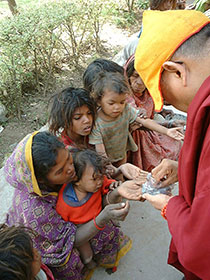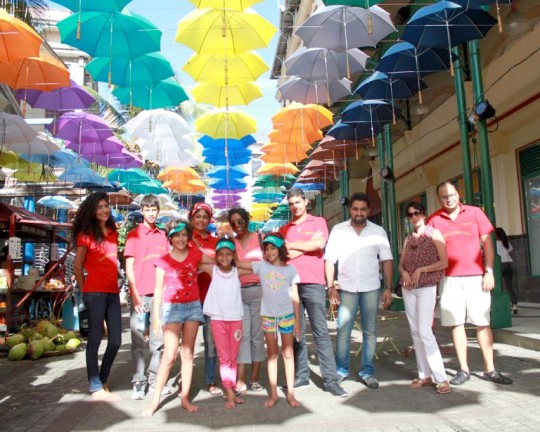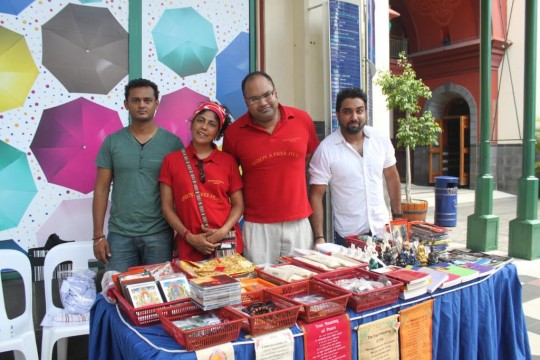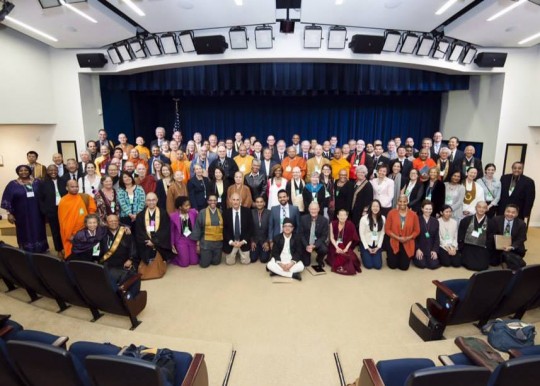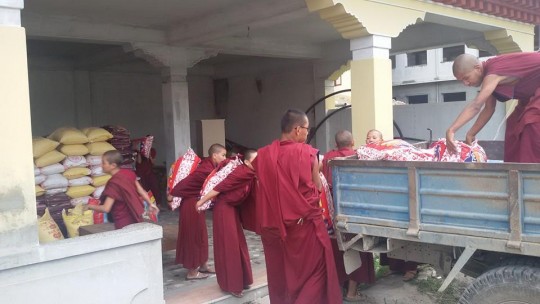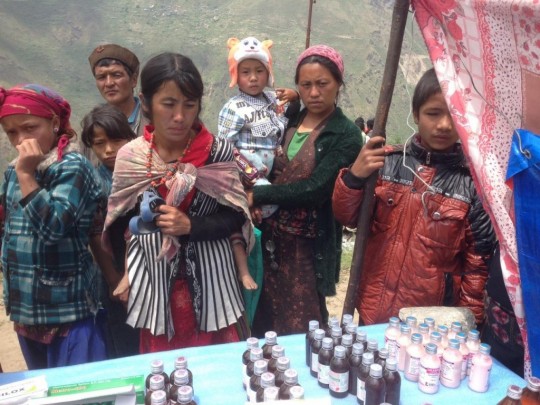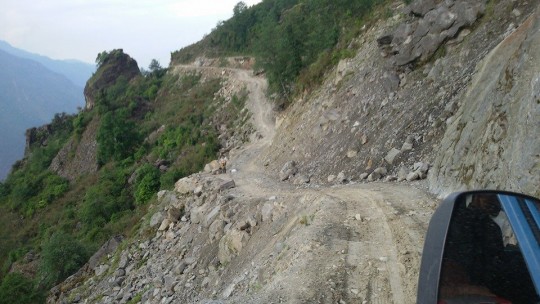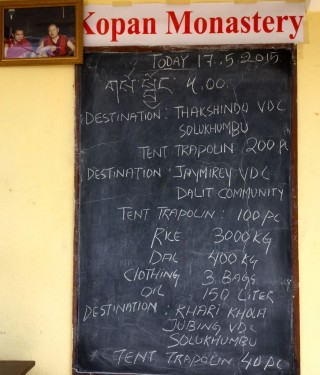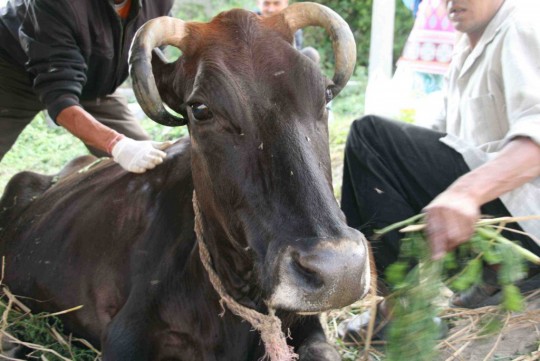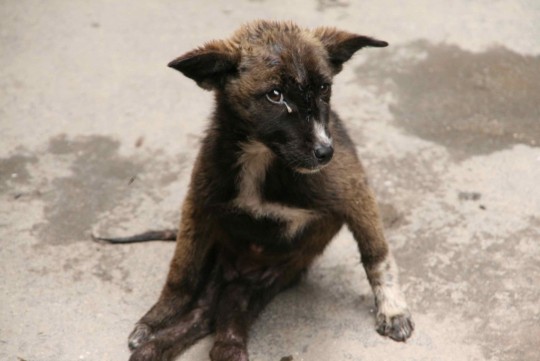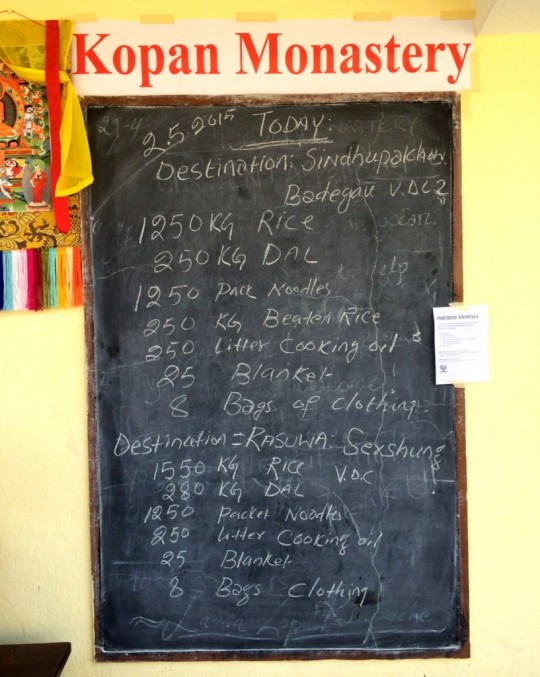- Home
- FPMT Homepage

Foundation for the Preservation of the Mahayana Tradition
The FPMT is an organization devoted to preserving and spreading Mahayana Buddhism worldwide by creating opportunities to listen, reflect, meditate, practice and actualize the unmistaken teachings of the Buddha and based on that experience spreading the Dharma to sentient beings. We provide integrated education through which people’s minds and hearts can be transformed into their highest potential for the benefit of others, inspired by an attitude of universal responsibility and service. We are committed to creating harmonious environments and helping all beings develop their full potential of infinite wisdom and compassion. Our organization is based on the Buddhist tradition of Lama Tsongkhapa of Tibet as taught to us by our founders Lama Thubten Yeshe and Lama Thubten Zopa Rinpoche.
- Willkommen
Die Stiftung zur Erhaltung der Mahayana Tradition (FPMT) ist eine Organisation, die sich weltweit für die Erhaltung und Verbreitung des Mahayana-Buddhismus einsetzt, indem sie Möglichkeiten schafft, den makellosen Lehren des Buddha zuzuhören, über sie zur reflektieren und zu meditieren und auf der Grundlage dieser Erfahrung das Dharma unter den Lebewesen zu verbreiten.
Wir bieten integrierte Schulungswege an, durch denen der Geist und das Herz der Menschen in ihr höchstes Potential verwandelt werden zum Wohl der anderen – inspiriert durch eine Haltung der universellen Verantwortung und dem Wunsch zu dienen. Wir haben uns verpflichtet, harmonische Umgebungen zu schaffen und allen Wesen zu helfen, ihr volles Potenzial unendlicher Weisheit und grenzenlosen Mitgefühls zu verwirklichen.
Unsere Organisation basiert auf der buddhistischen Tradition von Lama Tsongkhapa von Tibet, so wie sie uns von unseren Gründern Lama Thubten Yeshe und Lama Thubten Zopa Rinpoche gelehrt wird.
- Bienvenidos
La Fundación para la preservación de la tradición Mahayana (FPMT) es una organización que se dedica a preservar y difundir el budismo Mahayana en todo el mundo, creando oportunidades para escuchar, reflexionar, meditar, practicar y actualizar las enseñanzas inconfundibles de Buda y en base a esa experiencia difundir el Dharma a los seres.
Proporcionamos una educación integrada a través de la cual las mentes y los corazones de las personas se pueden transformar en su mayor potencial para el beneficio de los demás, inspirados por una actitud de responsabilidad y servicio universales. Estamos comprometidos a crear ambientes armoniosos y ayudar a todos los seres a desarrollar todo su potencial de infinita sabiduría y compasión.
Nuestra organización se basa en la tradición budista de Lama Tsongkhapa del Tíbet como nos lo enseñaron nuestros fundadores Lama Thubten Yeshe y Lama Zopa Rinpoche.
A continuación puede ver una lista de los centros y sus páginas web en su lengua preferida.
- Bienvenue
L’organisation de la FPMT a pour vocation la préservation et la diffusion du bouddhisme du mahayana dans le monde entier. Elle offre l’opportunité d’écouter, de réfléchir, de méditer, de pratiquer et de réaliser les enseignements excellents du Bouddha, pour ensuite transmettre le Dharma à tous les êtres. Nous proposons une formation intégrée grâce à laquelle le cœur et l’esprit de chacun peuvent accomplir leur potentiel le plus élevé pour le bien d’autrui, inspirés par le sens du service et une responsabilité universelle. Nous nous engageons à créer un environnement harmonieux et à aider tous les êtres à épanouir leur potentiel illimité de compassion et de sagesse. Notre organisation s’appuie sur la tradition guéloukpa de Lama Tsongkhapa du Tibet, telle qu’elle a été enseignée par nos fondateurs Lama Thoubtèn Yéshé et Lama Zopa Rinpoché.
Visitez le site de notre Editions Mahayana pour les traductions, conseils et nouvelles du Bureau international en français.
Voici une liste de centres et de leurs sites dans votre langue préférée
- Benvenuto
L’FPMT è un organizzazione il cui scopo è preservare e diffondere il Buddhismo Mahayana nel mondo, creando occasioni di ascolto, riflessione, meditazione e pratica dei perfetti insegnamenti del Buddha, al fine di attualizzare e diffondere il Dharma fra tutti gli esseri senzienti.
Offriamo un’educazione integrata, che può trasformare la mente e i cuori delle persone nel loro massimo potenziale, per il beneficio di tutti gli esseri, ispirati da un’attitudine di responsabilità universale e di servizio.
Il nostro obiettivo è quello di creare contesti armoniosi e aiutare tutti gli esseri a sviluppare in modo completo le proprie potenzialità di infinita saggezza e compassione.
La nostra organizzazione si basa sulla tradizione buddhista di Lama Tsongkhapa del Tibet, così come ci è stata insegnata dai nostri fondatori Lama Thubten Yeshe e Lama Zopa Rinpoche.
Di seguito potete trovare un elenco dei centri e dei loro siti nella lingua da voi prescelta.
- 欢迎 / 歡迎
简体中文
“护持大乘法脉基金会”( 英文简称:FPMT。全名:Foundation for the Preservation of the Mahayana Tradition) 是一个致力于护持和弘扬大乘佛法的国际佛教组织。我们提供听闻,思维,禅修,修行和实证佛陀无误教法的机会,以便让一切众生都能够享受佛法的指引和滋润。
我们全力创造和谐融洽的环境, 为人们提供解行并重的完整佛法教育,以便启发内在的环宇悲心及责任心,并开发内心所蕴藏的巨大潜能 — 无限的智慧与悲心 — 以便利益和服务一切有情。
FPMT的创办人是图腾耶喜喇嘛和喇嘛梭巴仁波切。我们所修习的是由两位上师所教导的,西藏喀巴大师的佛法传承。
繁體中文
護持大乘法脈基金會”( 英文簡稱:FPMT。全名:Found
ation for the Preservation of the Mahayana Tradition ) 是一個致力於護持和弘揚大乘佛法的國際佛教組織。我們提供聽聞, 思維,禪修,修行和實證佛陀無誤教法的機會,以便讓一切眾生都能 夠享受佛法的指引和滋潤。 我們全力創造和諧融洽的環境,
為人們提供解行並重的完整佛法教育,以便啟發內在的環宇悲心及責 任心,並開發內心所蘊藏的巨大潛能 — 無限的智慧與悲心 – – 以便利益和服務一切有情。 FPMT的創辦人是圖騰耶喜喇嘛和喇嘛梭巴仁波切。
我們所修習的是由兩位上師所教導的,西藏喀巴大師的佛法傳承。 察看道场信息:
- FPMT Homepage
- News/Media
-
- Study & Practice
-
-
- About FPMT Education Services
- Latest News
- Programs
- New to Buddhism?
- Buddhist Mind Science: Activating Your Potential
- Heart Advice for Death and Dying
- Discovering Buddhism
- Living in the Path
- Exploring Buddhism
- FPMT Basic Program
- FPMT Masters Program
- FPMT In-Depth Meditation Training
- Maitripa College
- Lotsawa Rinchen Zangpo Translator Program
- Universal Education for Compassion & Wisdom
- Online Learning Center
-
- Prayers & Practice Materials
- Overview of Prayers & Practices
- Full Catalogue of Prayers & Practice Materials
- Explore Popular Topics
- Benefiting Animals
- Chenrezig Resources
- Death & Dying Resources
- Lama Chopa (Guru Puja)
- Lama Zopa Rinpoche: Compendium of Precious Instructions
- Lama Zopa Rinpoche: Life Practice Advice
- Lama Zopa Rinpoche Practice Series
- Lamrim Resources
- Mantras
- Prayer Book Updates
- Purification Practices
- Sutras
- Thought Transformation (Lojong)
- Audio Materials
- Dharma Dates - Tibetan Calendar
- Translation Services
- Publishing Services
- Ways to Offer Support
- Prayers & Practice Materials
-
- Teachings and Advice
- Find Teachings and Advice
- Lama Zopa Rinpoche Advice Page
- Lama Zopa Rinpoche: Compendium of Precious Instructions
- Lama Zopa Rinpoche Video Teachings
- ༧སྐྱབས་རྗེ་བཟོད་པ་རིན་པོ་ཆེ་མཆོག་ནས་སྩལ་བའི་བཀའ་སློབ་བརྙན་འཕྲིན།
- Podcasts
- Lama Yeshe Wisdom Archive
- Buddhism FAQ
- Dharma for Young People
- Resources on Holy Objects
- Teachings and Advice
-
-
*If a menu item has a submenu clicking once will expand the menu clicking twice will open the page.
-
-
- Centers
-
- Teachers
-
- Projects
-
-
-
-
*If a menu item has a submenu clicking once will expand the menu clicking twice will open the page.
-
-
- FPMT
-
-
-
-
-
Proper guru devotion – correct devotion to your virtuous friends – allows you to actualize successfully all the steps of the path to enlightenment, from the perfect human rebirth up to buddhahood itself.
Lama Zopa Rinpoche
-
-
-
- Shop
-
-
-
The Foundation Store is FPMT’s online shop and features a vast selection of Buddhist study and practice materials written or recommended by our lineage gurus. These items include homestudy programs, prayers and practices in PDF or eBook format, materials for children, and other resources to support practitioners.
Items displayed in the shop are made available for Dharma practice and educational purposes, and never for the purpose of profiting from their sale. Please read FPMT Foundation Store Policy Regarding Dharma Items for more information.
-
-
FPMT News Around the World
18

Korean Jade Buddha tour office, Incheon, Korea, April 2015. Photo courtesy of Ian Green.
“The official Jade Buddha for Universal Peace tour office has opened in Korea,” reported director Ian Green. “Located in Incheon, near the South Korean capital city of Seoul, the office will organize the tour of the Jade Buddha which will involve showings in most large cities in South Korea from March 1 to August 31, 2017.
“The office is hopeful that the Jade Buddha tour will also include a showing in Pyongyang, the capital of North Korea. The stated aims of the Jade Buddha Korea committee are to further the causes of peace and unification for Korea. Korean residents and Korean speakers are welcome to support the tour. More information can be obtained from eunghwan2065@daum.net (Korean) and info@stupa.org.au (English).”
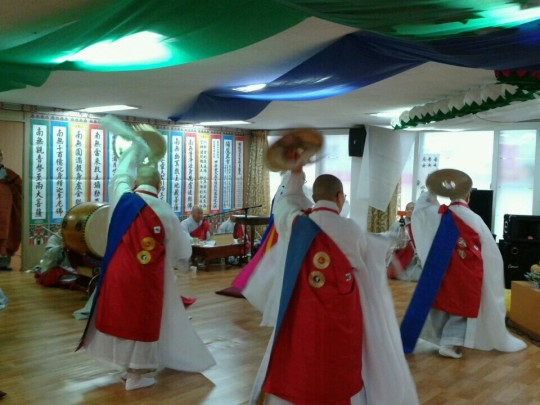
Korean Jade Buddha tour office, Incheon, Korea, April 2015. Photo courtesy of Ian Green.
Mandala brings you news of Lama Zopa Rinpoche and of activities, teachings and events from nearly 160 FPMT centers, projects and services around the globe. If you like what you read on Mandala, consider becoming a Friend of FPMT, which supports our work.
- Tagged: jade buddha for universal peace
- 0
15
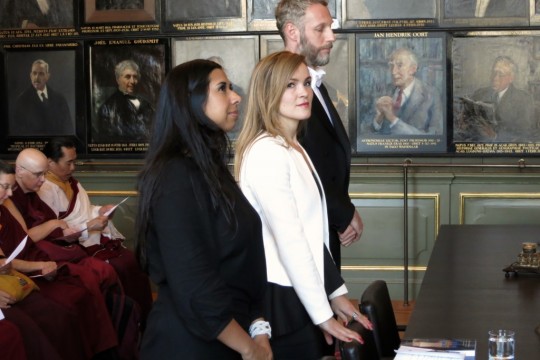
Berthe Jansen defending her dissertation, Leiden University, Leiden, Netherlands, February 2015. Photo by Bert Molenaar.
Director of Maitreya Instituut Amsterdam Paula De Wys-Koolkin shared this achievement from past Lotsawa Rinchen Zangpo Translator Programme (LRZTP) graduate Berthe Jansen:
On February 24, 2015, Berthe Jansen was awarded her Ph.D. at Leiden University in a ceremony rich in tradition and attended by family, friends, geshes, lama colleagues and mentors. Although the formal procedure itself was beautiful and impressive, many of those present were most moved by the knowledge that Berthe had earned her degree through sheer hard work and perseverance.
Berthe was sponsored by Maitreya Instituut to follow the FPMT’s interpreter training course, LRZTP, in Dharamsala from 2003 to 2005, and she graduated at the top of her class. She then moved back to the Netherlands with her young daughter Pema to work as an interpreter for Maitreya Instituut. She did that for two years while also studying at Leiden University, where she received her BA in Languages and Culture of India and Tibet in 2008. She then went on to study Tibetan and Himalayan Studies at Oxford University, receiving her M.Phil. with distinction in 2010.
Returning to Leiden, she began work on her Ph.D., and successfully defended her thesis – The Monastery Rules: Buddhist Monastic Organization in Pre-modern Tibet – by answering questions put to her by a panel of eminent scholars and professors from several European universities.
The setting was perfect for these impressive proceedings. Leiden University was founded in 1575, and the wood paneled room lined with centuries-old portraits, and the gowned dignitaries presiding over the occasion, emphasized the achievement that began in Dharamsala more than 10 years before.
Since then, while working on her studies, she has found time to be a single mother, did linguistic counter-expertise for immigration lawyers, and has been a freelance interpreter of Tibetan for several Buddhist teachers, including His Holiness the the Dalai Lama, Amnesty International, lawyers and courthouses, Dutch television, and some Dutch documentaries.
In a letter she wrote after her graduation from LRZTP to Ven. Kaye Miner, then the director of Maitreya Instituut Emst, Berthe said:
“I will definitely pray for the success of the Maitreya Instituut, and for that matter, the whole of the FPMT, now and whilst in Tibet. And not to forget, I’m extremely grateful that the Maitreya Instituut gave me the opportunity to study with the LRZTP; it’s something I won’t lightly forget, and therefore I’m greatly indebted to the center, FPMT and Lama Zopa Rinpoche.”
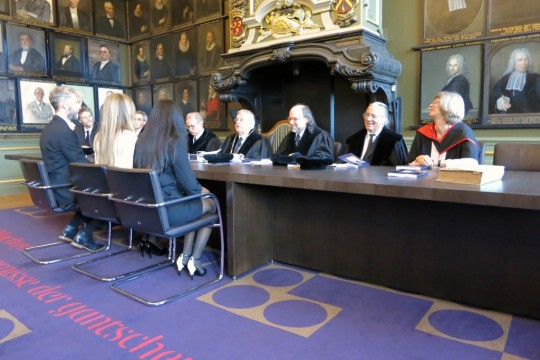
Berthe Jansen defending her dissertation, Leiden University, Leiden, Netherlands, February 2015. Photo by Bert Molenaar.
Mandala brings you news of Lama Zopa Rinpoche and of activities, teachings and events from nearly 160 FPMT centers, projects and services around the globe. If you like what you read on Mandala, consider becoming a Friend of FPMT, which supports our work.
8
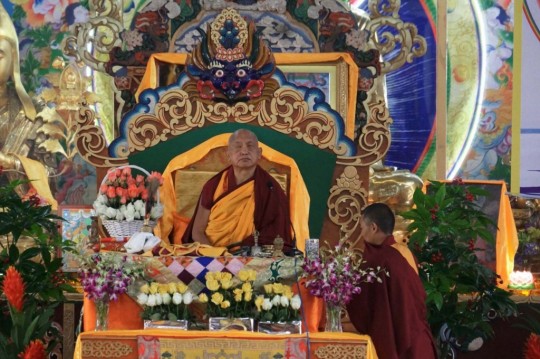
Lama Zopa Rinpoche teaching at 100 Million Mani Retreat, Ulaanbaatar, Mongolia, August 2014. Photo courtesy of Ganden Do Ngag Shedrup Ling.
Ven. Tsenla, director of Ganden Do Ngag Shedrup Ling in Mongolia, shared with Mandala news of the center’s activities over the last year, including the second annual 100 Million Mani Retreat and the arrival of their resident geshe:
Please rejoice with us in the tremendous success of the second annual 100 Million Mani Retreat hosted by Ganden Do Ngag Shedrup Ling Center in Ulaanbaatar from August 17 to September 18, 2014. The participants of the first and the second retreat well surpassed the mark of 100 million mantra recitations.
Many Mongolian people from near, far and wide attended and we were able to recognize familiar faces of participants from the first retreat together with several new people joining during the month. Attendance for the retreat averaged around 500 people.
The dedication and commitment of the Mongolian people to the practice of developing compassion is inspiring and we believe that the merit from their devotion was a large contributing factor to have the great good fortune of a visit from Lama Zopa Rinpoche and entourage for one precious week of Dharma rain. To have Rinpoche visit two years in a row for this event was beyond our expectations!
Rinpoche taught and showed the aspect of being extremely pleased with the efforts of the participants and again asked that the retreat be held annually and expanded his request to include that it also be held in other parts of Mongolia to cater for those people who find it difficult to come to Ulaanbaatar.
Preparations are now beginning for the third annual 100 Million Mani Retreat, scheduled from August 9 to the September 10, 2015.
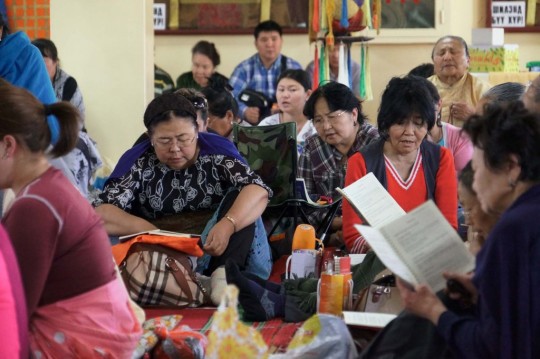
Participants at 100 Million Mani Retreat, Ulaanbaatar, Mongolia, August 2014. Photo courtesy of Ganden Do Ngag Shedrup Ling.
Renovations at the Center
The support and generosity of a very kind benefactor to the center enabled us to undertake somewhat major renovations at the center for some four months leading up to the mani retreat.
The center building was completed in 1999, not long after Mongolia’s freedom from occupation, at which time the quality of materials and workmanship was not of a high standard. In particular, we focused on the high priority of replacing the central heating panels and pipes in all rooms, replacing our very drafty and unsuitable windows for the harsh Mongolian winters with modern, double-glazed ones and the installation of new floor coverings. While it was a most disruptive and challenging few months, we are pleased to have that behind us and are now benefiting from the improvements.
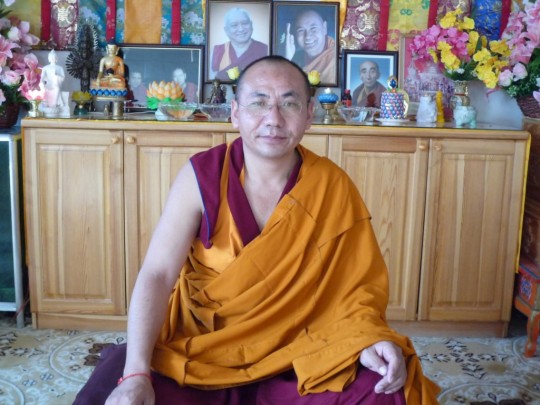
Geshe Lobsang Wangchuk. Photo courtesy of Ani Gyalmo.
New Resident Geshe
The Wood Sheep year started in a wonderful way for us with the joy and excitement of the arrival of our new resident geshe, Geshe Lobsang Wangchuk on February 24, 2015. Born in the Eastern part of Tibet, he became a monk at the age of 13 and in 1991 came to India to enter Sera Je Monastery to complete his studies in the five great philosophical treatises. When he completed his studies at Sera Je Monastery in 2008, he embarked on a life of retreat in the mountains of Dharamsala and Manali and spent his winters at the holy site of the Mahabodhi Stupa in Bodhgaya.
Geshe-la has an inspirational accomplishment of more than 700,000 prostrations; 1.5 million Migtsema prayers; 1.5 million Manjushri mantras; 1.1 million Chenrezig mantras; three Hayagriva retreats; three Solitary Hero Yamantaka retreats; and the Thirteen Deity Yamantaka retreat two times.
In 2011, in a private audience with His Holiness the Dalai Lama, Geshe-la was advised to actively engage in activities benefiting society and complete the examination for the formal Geshe degree. Upon completing his exams, he returned to his life of solitary retreats and practice.
In September 2014, Lama Zopa Rinpoche advised us to invite Geshe Lobsang Wangchuk and we are delighted that this important accomplishment could ripen.
Mandala brings you news of Lama Zopa Rinpoche and of activities, teachings and events from nearly 160 FPMT centers, projects and services around the globe. If you like what you read on Mandala, consider becoming a Friend of FPMT, which supports our work.
- Tagged: fpmt mongolia, ganden do ngag shedrup ling, mongolia
- 0
4
Shilpa Ramphul shared with Mandala some photos from Dharmarakshita Study Group’s March 2015 outreach activities in at at the Caudan Waterfront in Port Louis, Mauritius. “Dharmarakshita members and friends gathered to create more awareness of Buddhism and share mantras and auspicious items with the people. It was an amazing day with a lot of loving kindness that was showered upon all. And of course, we had the precious support of the Dharmarakshita children – priceless!”
In late March 2015, Dharmarakshita Study Group held an introductory Buddhist course. The group has weekly Dharma talks and study sessions in addition to organizing retreats, charitable service projects and yoga for its students.

Participants at Dharmarakshita Study Group’s “Introduction to Buddhism” course, Vacoas, Mauritius, March 2015. Photo courtesy of Dharmarakshita Study Group.
Mandala brings you news of Lama Zopa Rinpoche and of activities, teachings and events from nearly 160 FPMT centers, projects and services around the globe. If you like what you read on Mandala, consider becoming a Friend of FPMT, which supports our work.
- Tagged: dharmarakshita study group, mauritius
- 0
28
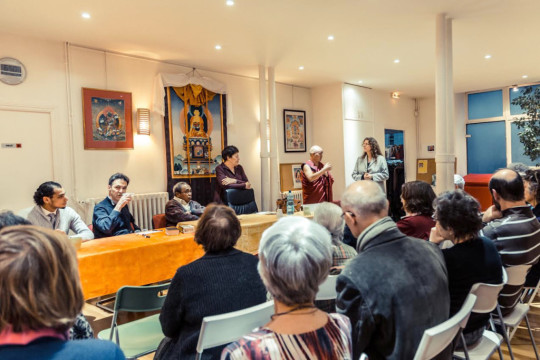
On March 5, Centre Kalachakra in Paris welcomed local religious leaders representing Catholicism, Protestantism, Buddhism and Islam. Fifty people attended the dialogue, which focused on the theme of joy and happiness.
Geshe Drakpa Tsundue, Centre Kalachakra’s resident geshe, welcomed all the participants, stressing the importance of religious dialogue specifically in Paris after the violence against Charlie Hebdo. He also introduced His Holiness the Dalai Lama’s main points concerning religious plurality and interfaith dialogue, namely, that differently religions suit different needs and interests; the importance of emphasizing the common values – such as compassion and forgiveness – shared between theistic and non-theistic traditions; the need to generate a sense of there being one human family; and the necessity of secular ethics in education to promote world peace.
“Father Quinson, representing Catholicism, said we can experience joy with Jesus being the mediator of joy,” said center director Ven. Elisabeth Drukier, who was also a presenter at the event. “Imam Mohamed replied we should give up aesthetic joy because the soul can’t be satisfied that way. Pastor Raharinaivo commented that joy comes only from Heaven. And I explained the Buddhist view of inner joy coming from peace of mind.
“Interfaith dialogue has been going on for the last 15 years in 10th arrondissement of Paris on different themes such as preparing for death, forgiveness, and freedom. We usually go to different churches, synagogues or mosques. Centra Kalachakra has hosted this event three times and we expect more after Charlie Hebdo as there is a feeling of urgency to have more interfaith dialogue.”
Mandala brings you news of Lama Zopa Rinpoche and of activities, teachings and events from nearly 160 FPMT centers, projects and services around the globe. If you like what you read on Mandala, consider becoming a Friend of FPMT, which supports our work.
25
On May 14, three FPMT students attended the first White House-US Buddhist Leadership Conference in Washington, D.C., which brought Buddhist leaders together to discuss politics and the policies most relevant to the country with current White House administration. Long-time student and director of Guhyasamaja Center Lorne Ladner shared this report:
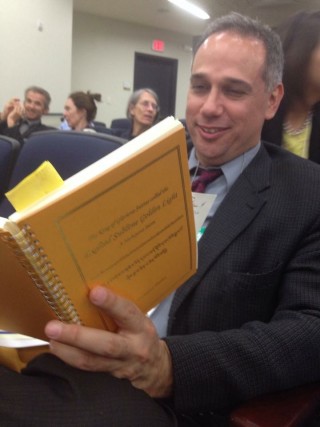
Lorne Ladner reading Sutra of Golden Light during the first White House-US Buddhist Leadership Conference in Washington, D.C., US, May 14, 2015.
The conference was organized by a number of Buddhist groups working together, led by William Aiken of Soka Gakkai who had previous connections with some folks at the White House. Over 120 Buddhists from many different Buddhist traditions and nations were invited. There were lay and monastic participants from many places including Japan, Vietnam, Burma, Thailand, Sri Lanka, and so on. A wide mix of people came from all around the US. One striking, positive feature of the group was it’s diversity – people of many cultures, races, nationalities, and Buddhist traditions coming together to share a positive perspective in the political arena.
It was quite nice in that Buddhists from a number of traditions shared about social efforts that they are making to do things like help with disaster relief, feed the hungry, decrease racism in the US and combat global warming. It was pretty inspiring to see that many different Buddhist groups are working to benefit others in wonderful ways. Everyone seemed quite friendly and harmonious.
The overall group had also drafted two statements to give to the White House – one expressing extreme concern about global climate change. This statement was in line with advice given previously by His Holiness the Dalai Lama about goals for decreasing carbon emissions to help on that issue. The other statement was about the problems of racism and how those relate to police violence and the prevalence of prisons in the US. I signed on to both of those because they were quite constructive.
After the presentations and the discussion about those documents, various government officials gave us a briefing and then answered questions at the White House. They focused on a number of issues including climate change, protecting the environment, the promotion of peace/non-violence, corporate greed, and decreasing racism in the US. Overall, it seemed like a positive first step in having the wise voice of the Buddhist tradition get more hearing in the context of the US political system. One thing that I saw clearly is that many groups in the US that have fewer members than Buddhism get more hearing because they focus more on having their voices heard on issues of importance to them. We Buddhists in the US tend to not focus on that so much!
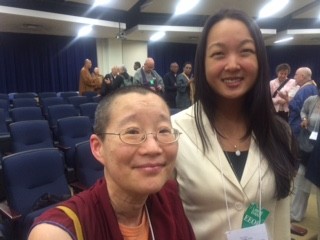
Ven. Losang Tendrol and Jennifer Kim, director of Shantideva Meditation Center in New York, at the White House-Buddhist Leadership Conference, Washington, D.C., May 14, 2015
Ven. Losang Tendrol and I were both there from Guhyasamaja Center. She brought her prayer wheel along and spun it during the meeting which was nice. Thinking of Lama Zopa Rinpoche’s many comments regarding it’s importance for peace, wise leadership and the protection of nations, I brought the Sutra of Golden Light and read some sections aloud during a break time with prayers. In terms of the overall meeting, there was also a point when members of the Sangha stood up and recited prayers including refuge. All the Buddhists together recited a version of the bodhisattva vow, which I think came from Japan.
The organizers said that they may likely organize another meeting like this next year at the US Capitol to meet with senators or congressional representatives. I want to try to help make sure that for next year they invite a few Tibetan monks as I think there was only one Tibetan person there this time. Perhaps this meeting is a step in the direction of greater compassionate engagement in the public sphere for Buddhists in this country.
For more on the meeting, see Lion’s Roar’s “Buddhist Go to the White House.”
Recitation of the Sutra of Golden Light for world peace is one of Lama Zopa Rinpoche’s Vast Visions for FPMT. FPMT Education Services has created a resource page to help you learn more about and start reciting the Sutra of Golden Light.
- Tagged: golden light sutra, lorne ladner, sutra of golden light
- 0
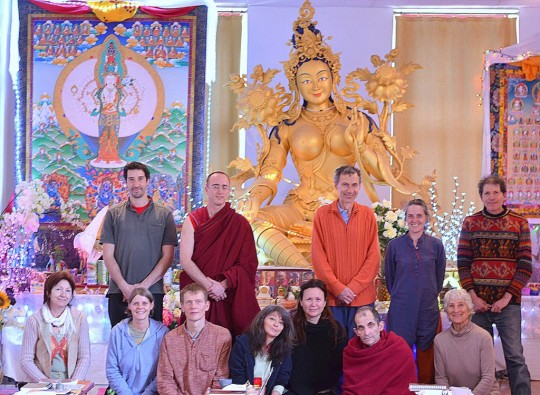
Participants in Institut Vajra Yogini’s fourth round of 108 nyung näs, Marzens, France, March 2015. Photo courtesy of Institut Vajra Yogini.
“Following up on the success of previous rounds of 108 nyung näs at Institut Vajra Yogini in France, the center started a fourth round in November 2014,” said director François Lecointre. “Midway through this fourth round, almost 600 nyung näs, an intensive two-day fasting retreat associated with Chenrezig, have already been accumulated by more than 80 different people.
“Five people still intend to do the full 108 nyung näs. To make it possible for people to commit to the whole seven months of this intense practice, each year Lama Zopa Rinpoche, through the Practice and Retreat Fund, is personally sponsoring up to 10 people willing to do 100 nyung näs.
“By starting this yearly retreat, Institut Vajra Yogini wished to help in making one of Rinpoche’s Vast Visions come true – that some practitioners might succeed in this life to complete 1,000 nyung näs.
“The nyung näs are open to anyone who wishes to join them. Some people come for eight nyung näs, some for one, some for just one session. Ven. Charles, who has guided the previous rounds, leads in French, but several people follow simultaneously in English.
“This year, we hope to accumulate at least 1,000 nyung näs by the end of this seven-month retreat. It is great to have such an opportunity to rejoice! Wherever you are in the world, any day and anytime until the end of June 2015, you can visualize the retreatants at Institut Vajra Yogini generating bodhichitta, prostrating, fasting, accumulating mantras, praying for peace, and you can rejoice in that intense purification and accumulation of merit.”
To learn more or offer to sponsor a retreatant, contact Institut Vajra Yogini.
A fifth round will be organized from mid-November 2015 to the end of June 2016. Please contact Institut Vajra Yogini if you are interested in participating in any way.
Mandala brings you news of Lama Zopa Rinpoche and of activities, teachings and events from nearly 160 FPMT centers, projects and services around the globe. If you like what you read on Mandala, consider becoming a Friend of FPMT, which supports our work.
- Tagged: institut vajra yogini, nyung nä
- 0
18

In Manthali Gaun, Raemchhap District, Nepal, May 2015. Photo courtesy of Kopan Monastery School on Facebook.
While the ground continues shaking in Nepal, Kopan monks and nuns continue their emergency relief work in several districts in Nepal. Since the April 25 earthquake, there have been well over 100 magnitude 4.0+ earthquakes. Kopan teams are delivering relief aid on trucks to remote villages and communities in many districts, including people of the Dalit (Untouchable) caste.
One team was on a four-day excursion to Rasuwa District, when the 7.3 earthquake struck on May 12. Kopan Monastery shared on Facebook that the team saw landslides and more destruction to homes. A medical team was traveling with the group. After returning, a medical team member said, “I think what they really need at this moment is proper shelters. Most of them plant their own food and get water from the waterfall, but difficult to get the shelter.” She concluded by saying, “There was too little that we could do for them. I wish we can do more to help.”
On May 16, the team returned to Rasuwa with two truckloads of tarpaulins and food, traveling 12 hours to arrive at their destination over very difficult roads.
Kopan Monastery School wrote on Facebook, “We saw so many relief team with huge loaded trucks heading toward this place. We were so relieved that now all the villagers around this area will get the relief supplies.
“What we learned is that Nepali people are so resilient. They looks sad, but much less worries than they supposed to be.”
Ven. Sarah Thresher shared, “To date the monks and nuns of Kopan Helping Hands have distributed:
- Food to 5,000 families
- Shelter to 1,135 families
- 3,000 meals
- Blankets to 500 families
- Clothing to 1,800 people
- Water distribution to many parts of the city…”
The Namgyal Rinpoche Foundation, which is the organization of Losang Namgyal Rinpoche, a Kopan monk and a high lama for the Tamang people, is coordinating with Kopan on relief work. They have most recently been sending supplies to Nuwakot District.
Geshe Thubten Jinpa, a senior Kopan Geshe, shared last week on his Facebook page, “Today we were traveling more than 18 hour on the road to deliver the relief package to the most affected area, every house along the road is completely down. It’s heartbreaking to witness these all with your own eyes. It’s 2 a.m. here. We just arrived back home. The road was so bad and the heavy rain made it extremely difficult. We sent for the people whom the relief package is targeted for and hand it over in the middle of jungle and head back, but have no other choices.”
Kopan Monastery is accepting donations directly for their relief work, mention “Kopan Helping Hands” in the comments: http://www.kopanmonastery.com/earthquake
To learn more and offer support to FPMT’s Nepal Earthquake Support Fund, which will be used for immediate relief and rebuilding: https://fpmt.org/support/socialservices/
For “Prayers and Practice for Earthquake in Nepal,” see:
https://fpmt.org/edu-news/prayers-and-practices-for-earthquake-in-nepal/
For continuing updates and news from Kopan Monastery and other FPMT centers and projects in Nepal affected by the earthquake, please visit our “Updates from Nepal after the Earthquake” page:
https://fpmt.org/nepal-earthquake/
- Tagged: kopan monastery, nepal earthquake
- 0
14
Phil Hunt, coordinator of the Animal Liberation Sanctuary at Kopan Monastery, has been helping not only the animals at Kopan, but other animals in Kathmandu and surrounding areas. Phil has been blogging about this work at Tree of Compassion. Here are a few excerpts from his posts:
Posted May 12
“During the latest larger earthquake in Nepal (measuring 7. 3 on the Richter scale) on Tuesday 12th of May we were on the second day of an animal rescue and assistance trip in the Nuwakot region, one of the worst affected areas from the original quakes. With our veterinarian Dr. Umesh Mandal, the SPCA Nepal, Nepal Veterinary Association and senior veterinary students, we were in the town of Devi Ghat when the rumbling started. People scrambled to the streets and open areas, screams and cries going out from fear and concern for others. A few minutes after the molecules of earth and beings settled people began working out what was newly damaged and what was no longer safe.
“… More fractures, slow healing wounds, downed animals, infections, abscesses, persistent diarrhoea and even a case of toxicity due to a home treatment remedy gone wrong (burnt motor oil smeared over a calf to treat a skin infection). We have seen food and medical aid getting to towns and villages in this area, which is so important, but helping the animals is also of great assistance to the people. They need these animals for their livelihood and they also treat them like family and worry for them. When their house is in ruins, when loved ones have died, when they are living in makeshift shelters and struggling, seeing an injured or sick animal get often lifesaving treatment is a great emotional (and financial) boost. …”
Posted May 2
“In the morning we headed out of Kathmandu Valley to a village where Dr. Umesh has been helping for some time. All along the way the devastation of the earthquake can be seen, with twisted and broken buildings scattered between the lucky ones with no apparent damage, the ones with small cracks, those with deep and ominous cracks, and those missing parts of walls and roofs. Out of the valley, it is clearer still in the rural communities that the traditional mud-brick or stone walls are the most affected as they have little mortar and certainly no metal rod internal support to hold them together.
“… We stop at one of the heads of the village. The cement and stone building is low and modest, even more so now as the entire main living area has lost its walls.
“… If the house had collapsed in its entirety, the cow and goats under the house would have been in trouble. Back in Kathmandu, 13 cows part of a backyard dairy were buried by a collapsing adjacent building. Only five could be rescued. In Nepal many people even in the city have one or two animals and small micro-farms are still important livelihoods.
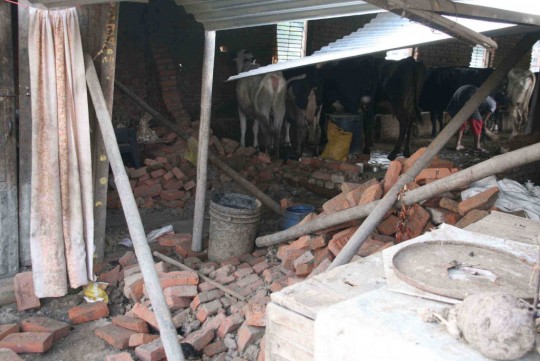
Dairy cows who survived the earthquake, Nepal, April 2015. Photo by Phil Hunt.
“After checking the animals in the village, the next call is to a small dairy back in the Kathmandu Valley. A large house has collapsed across the normal access road and it requires a detour. Other roads are also blocked due to unstable buildings. The proliferation of four-story buildings means the risk is magnified. At the dairy we check the buildings and animals. Walls came down, but the animals are all fortunately safe.
“A call comes in from near Bhaktapur of an injured cow, unable to stand. When we arrive, we see it is due to another wall collapse. The cow is under a temporary shelter. She wants to stand but can’t and is distressed. I fear the worst. Dr. Umesh methodically checks for injuries and the cause of the problem. Fortunately he finds it is only a broken rib and bruising and slight lacerations on her back from falling bricks. She is given analgesia for the pain and some other medication to help her mend. We will revisit and follow up. She also needs her hoofs trimmed as they are terribly overgrown. Family and friends gather around and are relieved that the cow will recover. A young girl sweeps biting insects from her side. …”
Posted May 1
“Another jolt in the night. Those that were here for the first two big quakes are hypersensitive to tremors and confess they are not sure sometimes whether they feel an actual tremor or it is their imagination.
“… It feels like a good day to stay put, hide in a dry corner like the monastery cat Shamatha. But knowing there are animals in distress that could be helped means there is no time for us to rest and makes every delay incredibly frustrating. Yesterday, several Israeli disaster response people were visiting the monastery. They were waiting for doctors to arrive before deploying.
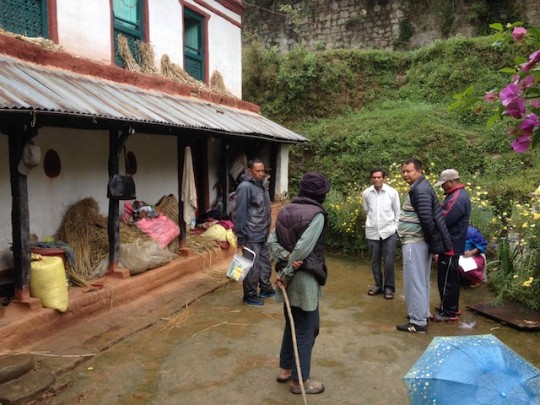
Government officially declared this cottage condemned, Nepal, April 2015. Photo by Phil Hunt.
“… This morning it was business as usual at the Animal Liberation Sanctuary, tending to animals requiring care and ensuring day-to-day operations are in hand. We had to avoid the damaged track and take the longer track below. There is no permanent road access to the land and most things are brought in on foot. Returning, we stopped at a lovely old traditional Nepalese mud-brick cottage that had been badly damaged in the earthquake. The owners were there along with some people from the government. They were assessing the damage and had just pronounced the building as unrecoverable. This decision allows the owners to move on, but it means another piece of Nepalese heritage will be gone from the landscape. It still is such a beautiful house and framed beautifully with many flowers. The mother cow and her calf survived without injury, but it will be many months of turmoil for the whole family no matter what decisions are made. …”
To read more from Animal Liberation Sanctuary coordinator Phil Hunt, visit the Tree of Compassion news blog.
For more updates and news from Kopan Monastery and other FPMT centers and projects in Nepal affected by the earthquake, visit our “Updates from Nepal after the Earthquake” page: https://fpmt.org/nepal-earthquake/
To learn more and offer support to the Nepal Earthquake Support Fund visit:
https://fpmt.org/support/socialservices/
For “Prayers and Practice for Earthquake in Nepal,” see:
https://fpmt.org/edu-news/prayers-and-practices-for-earthquake-in-nepal/
Mandala brings you news of Lama Zopa Rinpoche and of activities, teachings and events from nearly 160 FPMT centers, projects and services around the globe. If you like what you read on Mandala, consider becoming a Friend of FPMT, which supports our work.
- Tagged: animals, nepal earthquake, phil hunt
- 0
7
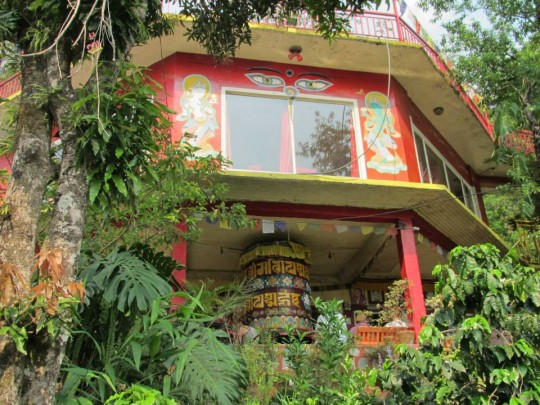
Ganden Yiga Chözin Buddhist Meditation Centre in Pokhara, April 2014. Photo via Facebook, Pokhara Buddhist Meditation Centre.
Ganden Yiga Chözin Buddhist Meditation Centre in Pokhara (about 200 km/120 miles from Kathmandu) was the only FPMT center in Nepal to not experience structural damage by the recent earthquake. Director Drolkar Maree Court shared in an email how the earthquake affected their weekend meditation course and what life is like in Pokhara now:
Sent April 28
The earthquake was very intense and scary and happened during the weekend course when we were on the topic of karma and the delusions. The quake lasted about two minutes and we ran into the garden, watching the neighbor’s building that was under construction, but nothing fell down. We have some cracks in garden walls, but that’s about it. And there was some smashed tsa-tsas in the tsa-tsa house on top of the gompa.
The next day when we again had class, we had a pretty big aftershock and the students just flew out the door this time. The day before they’d left quite slowly – a little too slowly it seemed though – I was at the back! But after that, they were very jittery and frightened. Pokhara is relatively unscathed. Just a few houses collapsed apparently and only one or two deaths, which is bad, of course, but nothing like anywhere else.
Since then, we’ve had to deal with all the anxious students who were here on the weekend. We had 26, which was a great number, but I think now that will be it for this season.
… And the weather’s been really bad lately, even before the earthquake. Very strange.
Sent May 6
Pokhara is practically deserted of Westerners and the people here are feeling it. Usually, May is very busy with tourists and people expect to make enough money each tourist season to tide them over during the monsoon and winter months. The center is no exception. We need to make enough money during the two tourist seasons to keep the center running through those empty months. But now with all the tourists gone, you can see the worry on people’s faces as they sit outside empty shops and restaurants. Apparently, many people have already lost their jobs as the employers start to panic over income. I’m sure it’s the same all over Nepal, not just here, as Nepal relies so heavily on tourism.
Nobody is sure when the tourists will come again either. Let’s hope that September (post monsoon) brings a fresh wave of tourists to re-energize the economy.
For more news from Kopan Monastery and other FPMT centers and projects in Nepal affected by the earthquake, visit our “Updates from Nepal after the Earthquake” page:
https://fpmt.org/nepal-earthquake/
To learn more and offer support to the Nepal Earthquake Support Fund visit:
https://fpmt.org/support/socialservices/
For “Prayers and Practice for Earthquake in Nepal,” see:
https://fpmt.org/edu-news/prayers-and-practices-for-earthquake-in-nepal/
You can receive an email daily digest of news from FPMT.org, including our updates from Nepal, by signing up at this address:
https://fpmt.us6.list-manage.com/subscribe?u=97e3ebb09472d09e0e699efd3&id=b248a1a45e
Mandala brings you news of Lama Zopa Rinpoche and of activities, teachings and events from nearly 160 FPMT centers, projects and services around the globe. If you like what you read on Mandala, consider becoming a Friend of FPMT, which supports our work.
6
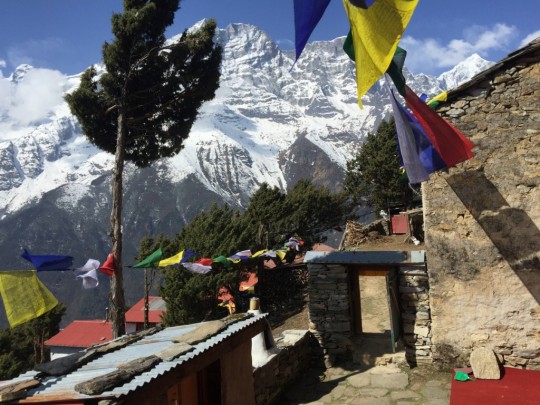
The view from Rinpoche’s cave in Lawudo two weeks before the earthquake, Nepal, April 2015. Photo by Ven. Roger Kunsang.
Lawudo Gompa and Retreat Centre, located in the mountainous Solu Khumbu region of Nepal, is an essential part of FPMT. “Lawudo is the heart where FPMT started,” FPMT spiritual director Lama Zopa Rinpoche has said. The cave at Lawudo is where Rinpoche’s previous incarnation Lawudo Lama Kunsang Yeshe meditated for 20 years. Many of the first Kopan monks came from the area and many FPMT students have meditated in the remote location.
Early reports from Lawudo describe considerable damage to the buildings there. On the top floor above the gompa, the side wall is badly cracked and pieces have fallen out. They fear the wall could fall down at anytime. In the dining room, half of the ceiling has fallen down due to the rocks that support the roof falling onto the ceiling. The side walls of the library have collapsed and the rocks supporting the roof have fallen through the ceiling. In the room of Ani Ngawang Samten, Rinpoche’s sister and manager of Lawudo, the rocks supporting the roof have fallen through the ceiling into the room. The cow shed side wall has collapsed as well as Nima’s house (Nima helps Ani Ngawang Samten maintain the center) and the buildings on both sides of the cave are badly cracked and pieces are falling out. In addition, walls have collapsed in the upper and lower retreat rooms.
Sangay Sherpa, Rinpoche’s brother who is the director of the center, has said that he has already booked a builder for the rebuilding, starting in a month. He plans to go to Lawudo soon himself and further assess the damage and begin collecting needed materials. The rebuilding of Lawudo will be supported by FPMT’s Nepal Earthquake Support Fund, which is funding both immediate emergency relief and the long-term rebuilding of FPMT centers and projects in Nepal.
Lawudo is also very near Thame, where Lama Zopa Rinpoche was born. Rinpoche feels a strong connection with the area and is supporting disaster relief efforts there. Through FPMT’s Nepal Earthquake Support Fund and in coordination with Cherok Lama Sherpa and the Himalayan Peoples Project-Nepal, an emergency aid shipment of tents for nearly 200 families in the region arrived last week. Next, food shipments will be sent up to the area, which is at an elevation of 3,800 meters (12,5000 feet) and only accessible by foot or helicopter.
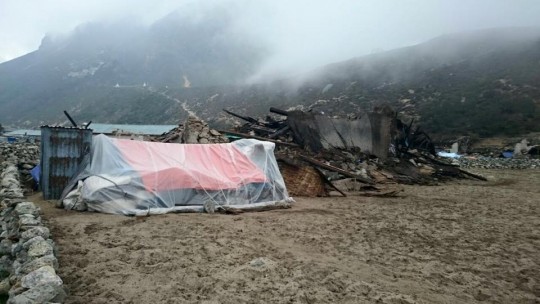
Tent shelters provided by emergency relief set up at Thame, Nepal, May 2015. Photo courtesy of Himalayan Peoples Project-Nepal
You can view Thame and the surrounding area on Google Maps or in a video created by Google Maps of the region, released in March 2015. National Geographic has posted photos of the destruction at Thame.
For more news from Kopan Monastery and other FPMT centers and projects in Nepal affected by the earthquake, visit our “Updates from Nepal after the Earthquake” page:
https://fpmt.org/nepal-earthquake/
To learn more and offer support to the Nepal Earthquake Support Fund visit:
https://fpmt.org/support/socialservices/
For “Prayers and Practice for Earthquake in Nepal,” see:
https://fpmt.org/edu-news/prayers-and-practices-for-earthquake-in-nepal/
You can receive an email daily digest of news from FPMT.org, including our updates from Nepal, by signing up at this address:
https://fpmt.us6.list-manage.com/subscribe?u=97e3ebb09472d09e0e699efd3&id=b248a1a45e
Mandala brings you news of Lama Zopa Rinpoche and of activities, teachings and events from nearly 160 FPMT centers, projects and services around the globe. If you like what you read on Mandala, consider becoming a Friend of FPMT, which supports our work.
- Tagged: lawudo, nepal earthquake, nepal earthquake relief fund, thame
- 0
4
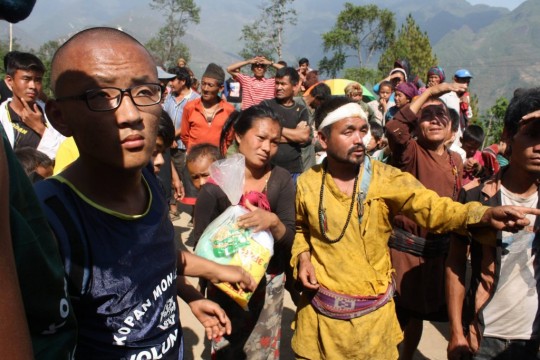
Kopan monks hand out emergency relief in Rasuwa, Nepal, May 2, 2015. Photo via Kopan Monastery School on Facebook.
Kopan Monastery monks continue to lead emergency relief efforts, going out to offer aid packages to people in villages far outside of Kathmandu. The Kopan monks are helping hundreds of families in a direct and organized way with rice, dal, oil, blankets, clothing and other supplies that are needed and that can be obtained.
Kopan Monastery staff have been sharing these reports on Facebook:
Day eight
As we are receiving lots of requests from the affected area, we are learning what we need to prepare. We had to shop and pack packages for tomorrow. Tomorrow we’ll be leaving around 6:00 a.m. with a load of foodstuff, blankets and tents. Thanks to all the monks for being all the time there to help. Specially those monks who donated all their extra blankets for the cause.
Today we opened our school after a week-long gap. We let our students discuss natural disasters and their causes. We also let them draw pictures about what they felt or think about the current situation.
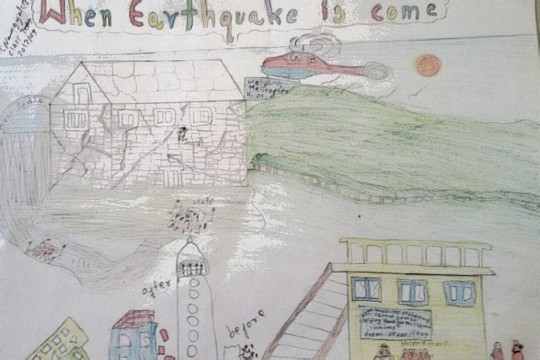
Drawing by grade 3 monk at Kopan Monastery, Nepal, May 3, 2015. Photo shared via Kopan Monastery School on Facebook where there are more drawings by students.
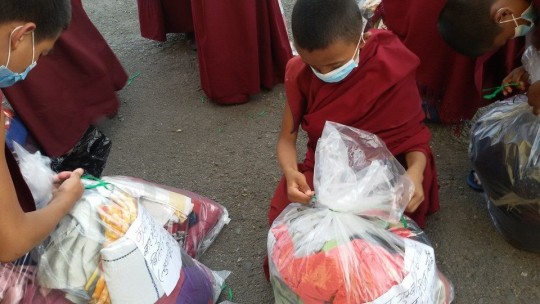
Young monks helping to prepare emergency relief, Kopan Monastery, Nepal, May 2, 2015. Photo courtesy Kopan Monastery School on Facebook.
Day seven
Last night we prepared all required things: blankets, clothes, and food packages, which include rice, oil, salt, beaten rices, etc. We again divided things into two trucks, one for Rasuwa and other one for Sindupalchok, and decided to leave at 6:00 a.m.
We woke up 5:30 a.m., loaded the packages, had a breakfast, then headed to Sindupalchok. It took us more than four hours to reach the place (Bade Gaon). The road up to this place is so bad that nobody would dare to go there. But thanks to our driver who dared to drop us there. On the way there is a little town by Melamche riverbank called Sipha Ghat that is almost 70% devastated. Then there’s another village called Ghote Gaun with 90% of houses devastated. All just like war zones. We were totally surprised that we’re the first to come here. At the same we felt very sorry for them that our relief supplies are too little to cover all of them.

Devastation seen along the way to distribute supplies, Nepal, May 2, 2015. Photo courtesy Kopan Monastery School on Facebook.
We climbed the rocky road about 6 kilometers and we finally reached our destiny (Bade Goun). Here also we saw the same situation with other villages though it’s not so populated an area, comparing with other villages. Moreover, there’s no shops and no proper roads and that makes for more suffering. The people around these areas are so humble. There’s no rushing and crowding like we faced in Kathmandu valley in other days.
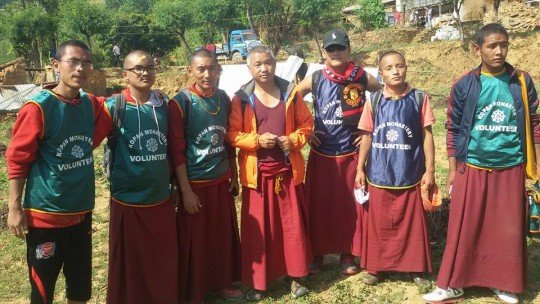
Some Kopan Monastery monks involved in relief work, Nepal, May 2, 2015. Photo courtesy Kopan Monastery School on Facebook.
They lined up and called each person from each house to get the supplies. I saw each person giving big smiles under their sad faces when they get their supplies. Everyone staying in the field. They insisted on us to have a lunch, some asked us to see their destroyed houses. My eyes got wet. I wish to cry aloud but how can I do that in front of them. We all went to see their devastated house. They’re asking whether we are coming again or not. I was speechless to their questions. We called to Radio Nepal and reported all the situations and asked them to send a help immediately. … We distributed all things in ward 4, 2 and 3. Then we had our lunch with their cattle, where they settled as their camp. They’re not willing to take money, but we insisted that they have at least 1000 Nepalese rupees.
We learned that the urgent things they needs are tents, blankets and mosquito nets. We were a little happy when we saw on the way back that Sikkim relief groups are going towards Sindupalchok. If anyone interested to go these area to help, make sure to carry those three things, please!!!
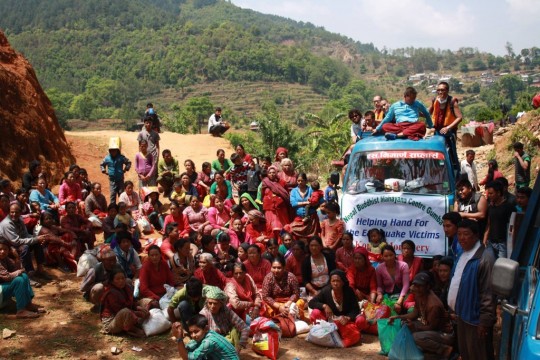
Kopan monks with villagers in Tare Bir Gaon, Nepal, May 2, 2015. Photo via Kopan Monastery School on Facebook.
For the latest updates and news from Kopan Monastery and other FPMT centers and projects in Nepal affected by the earthquake, visit our “Updates from Nepal after the Earthquake” page:
https://fpmt.org/nepal-earthquake/
To learn more and offer support to the Nepal Earthquake Support Fund visit:
https://fpmt.org/support/socialservices/
For “Prayers and Practice for Earthquake in Nepal,” see:
https://fpmt.org/edu-news/prayers-and-practices-for-earthquake-in-nepal/
More frequent updates and news can be found on FPMT’s Facebook page.
Mandala brings you news of Lama Zopa Rinpoche and of activities, teachings and events from nearly 160 FPMT centers, projects and services around the globe. If you like what you read on Mandala, consider becoming a Friend of FPMT, which supports our work.
- Tagged: kopan monastery, nepal earthquake
- 0
- Home
- News/Media
- Study & Practice
- About FPMT Education Services
- Latest News
- Programs
- New to Buddhism?
- Buddhist Mind Science: Activating Your Potential
- Heart Advice for Death and Dying
- Discovering Buddhism
- Living in the Path
- Exploring Buddhism
- FPMT Basic Program
- FPMT Masters Program
- FPMT In-Depth Meditation Training
- Maitripa College
- Lotsawa Rinchen Zangpo Translator Program
- Universal Education for Compassion & Wisdom
- Online Learning Center
- Prayers & Practice Materials
- Overview of Prayers & Practices
- Full Catalogue of Prayers & Practice Materials
- Explore Popular Topics
- Benefiting Animals
- Chenrezig Resources
- Death & Dying Resources
- Lama Chopa (Guru Puja)
- Lama Zopa Rinpoche: Compendium of Precious Instructions
- Lama Zopa Rinpoche: Life Practice Advice
- Lama Zopa Rinpoche Practice Series
- Lamrim Resources
- Mantras
- Prayer Book Updates
- Purification Practices
- Sutras
- Thought Transformation (Lojong)
- Audio Materials
- Dharma Dates – Tibetan Calendar
- Translation Services
- Publishing Services
- Teachings and Advice
- Find Teachings and Advice
- Lama Zopa Rinpoche Advice Page
- Lama Zopa Rinpoche: Compendium of Precious Instructions
- Lama Zopa Rinpoche Video Teachings
- ༧སྐྱབས་རྗེ་བཟོད་པ་རིན་པོ་ཆེ་མཆོག་ནས་སྩལ་བའི་བཀའ་སློབ་བརྙན་འཕྲིན།
- Podcasts
- Lama Yeshe Wisdom Archive
- Buddhism FAQ
- Dharma for Young People
- Resources on Holy Objects
- Ways to Offer Support
- Centers
- Affiliates Area
- Teachers
- Projects
- Charitable Projects
- Make a Donation
- Applying for Grants
- News about Projects
- Other Projects within FPMT
- Support International Office
- Projects Photo Galleries
- Give Where Most Needed
- FPMT
- Shop
Subscribe to FPMT News
Translate*
*powered by Google TranslateTranslation of pages on fpmt.org is performed by Google Translate, a third party service which FPMT has no control over. The service provides automated computer translations that are only an approximation of the websites' original content. The translations should not be considered exact and only used as a rough guide.Practice with the bodhisattva attitude every day. People can’t see your mind; what people see is a manifestation of your attitude in your actions of body and speech. So pay attention to your attitude all the time. Guard it as if you are the police, or like a parent cares for a child, like a bodyguard, or as if you are the guru and your mind is your disciple.






